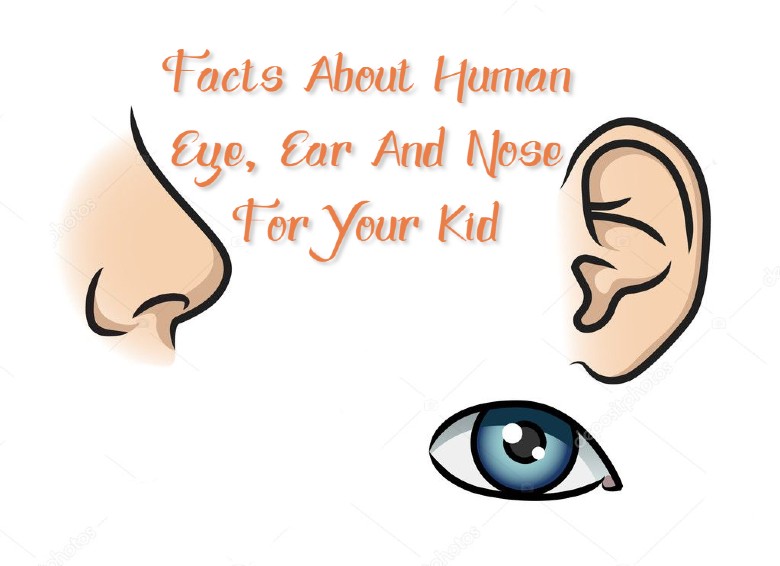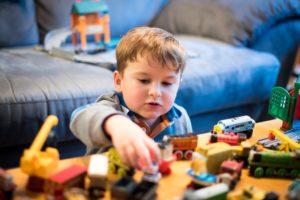Every child is curious. They ask several questions and some of them may even amaze you at times. But it is up to you to provide them with the right kind of information. This is their age to grow and develop into a smarter and more aware human being. We have collected some amazing facts related to the human eyes, ears, and nose. This will help you to grow interested in your child about the human body and the functions of different body parts. This may even make them an outstanding student in their classroom!
Eyes, ears, and nose are the basics of the human body. One cannot function completely without the absence of any one of them. It makes a person rely on different sources if they are incapable of using these body parts. Therefore, they consist of great importance and your child must be aware of the facts related to these body parts.
Eye Facts
- Eyes detect light and allow us to see.
- The information our eyes receive is sent to our brain along the optic nerve. This information is then processed by our brain and helps us make appropriate decisions, for example if you can see an object flying in your direction then you will probably move quickly out of the way.
- Around 95% of animals have eyes. Some are very simple, just picking up light and dark conditions while others are more complex, allowing for the recognition of shapes, color and depth.
- Like humans, some animals have eyes placed close together that allow for improved depth perception, others have eyes spread further apart (often on opposite sides of their head, as in horses) to allow for a greater field of view and an early warning against potential predators.
- The light sensitive tissue lining the inner surface of your eye is known as the retina, acting in a similar way to film in a traditional camera.
- Cone cells in the retina detect color while rod cells detect low light contrasts.
- The part of the eye that allows us to focus on different things in known as the lens, it changes shapes so we can focus on objects at various distances.
-
The cornea is the transparent covering of the iris and pupil, along with the lens it refracts light so it can be projected onto the retina.
- The central opening of your eye is known as the pupil, it changes size depending on the amount of light.
- The colored area around the pupil is called the iris, it controls the size of the pupil and can be colored brown, blue, green or other colors and shades depending on the person.
- Scientists believe that animal eyes evolved around 500 million years ago, beginning in simple form (perhaps just distinguishing light and dark) but giving a distinct advantage. This advantage led to eyes evolving quickly amongst animals (by evolutionary standards) as those without the ability to see struggled to survive against those that could.
-
Human eyes contain a small blind spot where the optic nerve passes through the retina. Our brains use information from the other eye to fill in the vision gap so it is rarely, if ever, noticed.
- Glasses and other protective equipment are often worn by humans to protect the eyes from UV rays or during various dangerous activities such as welding.
- Glasses and contact lenses are worn to correct common sight conditions such as short and long sightedness.
Ear Facts
- Our ears help us detect sound.
- Ears convert sound waves into nerve impulses that are sent to the brain.
- While your ears pick up the sound, it is your brain that does the hard work of making sense of it all.
- There is much more to the ear than the part you can see on the outside of your head.
- The middle part of the ear (behind the ear drum) amplifies sound pressure.
- The middle ear also contains the Eustachian tube which helps equalize pressure and drain mucus.
-
Ear infections are more common in children because of their developing immune systems and differences between their Eustachian tubes and those of adults.
- The inner ear is found inside the temporal bone, the hardest bone in the human body.
- The inner ear contains the spiral shaped hearing organ called the cochlea as well as the vestibule and semicircular canals which help with balance.
- Sounds waves are passed from air to liquid in the inner air. The inner air also contains tiny hair cells which react to sound waves, triggering chemicals that are sent to the brain as nerve impulses.
- Abnormalities in the inner ear of humans can cause deafness.
- Skin glands in the ear canal produce ear wax which helps protect the ear by lubricating it and cleaning it of dirt and dust.
- Excessive ear wax can impair hearing, especially if it is pressed hard against the eardrum.
- Ear wax normally comes out of your ear naturally so it’s not a good idea to try and remove it yourself unless it is causing health problems (best to see your doctor first).
- Piercing earlobes and ornamenting them with jewellery has been common practice around the world for thousands of years for both for cultural and cosmetic reasons.
Nose Facts
- The nose has special cells which help us smell.
- The technical term for sense of smell is ‘olfaction’.
- Your nose can help detect dangerous chemicals in the air.
- The human nose can smell many different odors but is far less sensitive than other animals such as dogs.
- The human nose has 2 nostrils.
- The 2 nostrils are divided by the nasal septum.
- The nasal septum is made up mostly of cartilage, a tissue that is stiffer than muscle but more flexible than bone.
- Found at the roof of the nose, the ethmoid bone separates the nasal cavity and brain.
- The ethmoid bone is also one of the bones that make up the orbit of the human eye.
- The nasal cavity is a large space found inside the head, above and behind the nose.
- Air passing through the nasal cavity is warmed to match body temperature (or cooled if it is very hot).
- Dust and other particles are removed in the nasal cavity by short hairs.
- The floor of the nasal cavity is also the roof of the mouth.
- ‘Anosmia’ is the inability to smell.
- ‘Dysosmia’ is when things don’t smell as they should.
- ‘Hyperosmia’ is having a very strong sense of smell.
- On average, men have larger noses than women.
- It is traditional for Maori people in New Zealand to press noses (hongi) as a greeting.
- Plastic surgery involving the nose is called ‘rhinoplasty’.
Also read – Facts about human bones, Skeletons and muscles













